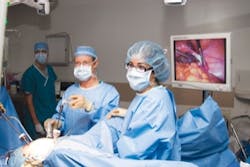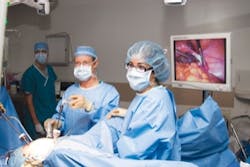Laser-induced nanobubbles kill cancer cells
When short laser pulses strike gold nanoparticles, nanobubbles form–and Rice University (Houston, TX) scientists have found that they can tune the lasers to create either small, bright bubbles that are visible but harmless, or large bubbles that burst cells.
In laboratory studies published last year, Rice physicist Dmitri Lapotko and colleagues at the Laboratory for Laser Cytotechnologies at the A.V. Lykov Heat and Mass Transfer Institute (Minsk, Belarus), used them to blast through arterial plaque. "The bubbles work like a jackhammer," Lapotko said.
Dmitri Lapotko and Jason Hafner (left to right) use lasers to create cell-bursting nanobubbles (photo courtesy Jeff Fitlow/Rice University).
Now, Lapotko and Rice professor Jason Hafner have tested the bubbles on leukemia cells and cells from head and neck cancers. They attached antibodies to the nanoparticles in order to target only cancer cells, and found the technique was effective at locating and killing them. The work is described in the February 26, 2010 issue of Nanotechnology.
The technology could be used for "theranostics," a single process that combines diagnosis and therapy. In addition, because the nanobubbles show up on microscopes in real time, the technique can be use for post-therapeutic assessment.
More Brand Name Current Issue Articles
More Brand Name Archives Issue Articles

